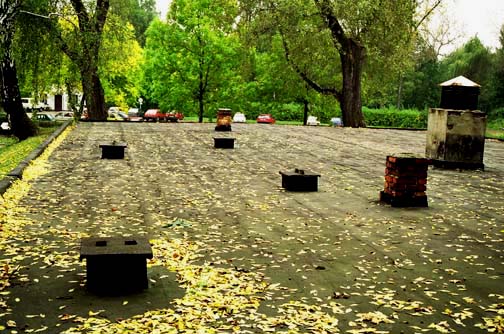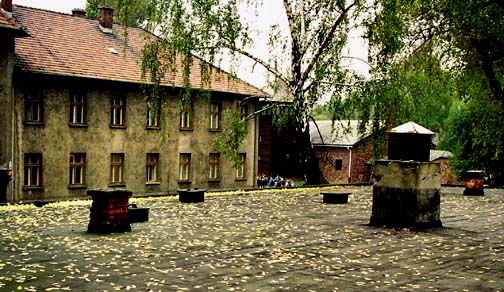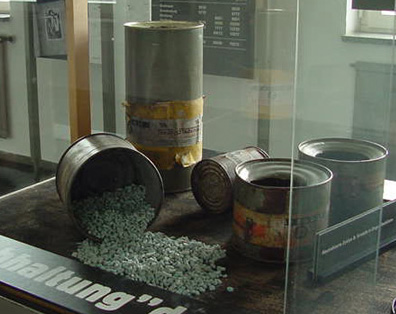Openings on roof of Auschwitz
Gas Chamber

Openings on roof of
gas chamber, 1998 photo
The photograph above shows the roof of
the Krema I gas chamber and crematorium building in the Auschwitz
main camp as it looked in October 1998. On the right, you can
see a red brick chimney of the type used for a stove. Behind
it is another larger chimney over the area where the cremtory
ovens were located; there were two of these chimneys, but one
is out of camera range in this photo. At the far end of the roof,
there is another chimney which is not located over the gas chamber
area.
The gassing of the victims in Krema I
at Auschwitz was done by pouring Zyklon-B gas pellets into the
gas chamber room through holes in the roof. One of these reconstructed
holes is shown in the foreground on the left in the photo above;
the other three holes are behind it. The reconstructed holes
are covered by wooden lids, just like the original holes; the
lids can be lifted up today, just as they were by the SS men
who poured the gas pellets into the gas chamber.
Jean Claude Pressac wrote in his book
"Auschwitz: Technique and Operation of the Gas Chambers"
that there were originally three holes in a straight line on
the roof of Krema I. According to the book entitled "Auschwitz
1270 to the Present," by Robert Jan van Pelt and Deborah
Dwork, the Nazis had "punched three square portholes through
the morgue roof and covered them with tightly fitting wooden
lids."
The original holes for the gas pellets
were closed up when the room was converted into a bomb shelter
by the Nazis in 1944, although this was not mentioned in the
construction plans.
After closing the original holes on the
roof, two new holes were cut for a ventilation system when the
gas chamber was converted into an air raid shelter. The ventilation
holes on the roof have since been closed up, but can still be
seen on the ceiling inside the gas chamber, as shown in the photo
below.
 Closed up vent hole
on ceiling of Auschwitz I gas chamber
Closed up vent hole
on ceiling of Auschwitz I gas chamber
Contrary to Jean-Claude Pressac's description
of "three" original holes on the roof, a statement
by Hans Stark, a member of the SS staff at Auschwitz, describes
only two holes on the roof of Krema I.
The following quote from Hans Stark is
from the book entitled "The Good Old Days," by Klee,
Dressen and Riess:
At another, later gassing--also in
autumn 1941--Grabner ordered me to pour Zyklon B into the opening
because only one medical orderly had shown up. During a gassing
Zyklon B had to be poured through both openings of the gas-chamber
room at the same time. This gassing was also a transport of 200-250
Jews, once again men, women and children. As the Zyklon B--as
already mentioned--was in granular form, it trickled down over
the people as it was being poured in. They then started to cry
out terribly for they now knew what was happening to them. I
did not look through the opening because it had to be closed
as soon as the Zyklon B had been poured in. After a few minutes
there was silence. After some time had passed, it may have been
ten to fifteen minutes, the gas chamber was opened. The dead
lay higgledy-piggedly all over the place. It was a dreadful sight.
Filip Müller, the author of "Eye
Witness, Three Years in the Gas Chambers," wrote that there
were six openings on the roof and several SS men poured the gas
pellets into the room. Müller wrote, regarding the job of
the SS men:
They removed the covers from the six
camouflaged openings. Then, protected by gas masks, they poured
the green-blue crystals of the deadly gas into the gas chamber.
Müller also wrote that the noise
from truck engines was used to "prevent anyone from hearing
the shouting and banging on doors of the dying in the gas chamber."
Pery Broad, an SS man who worked in the
Gestapo office next door to the gas chamber, corroborates Müller's
description of six holes. Broad wrote a report, after he was
captured by the British, in which he described how the gas pellets
were poured into the Krema I gas chamber: "... the covers
had been removed from the six holes in the ceiling..."
The web site of Emory University claims that
there were originally five holes on the roof of Krema I:
Originally Crema 1 was equipped with
three ovens with a morgue room behind them. In late 1941 the
morgue room in Crema 1 was sealed up, five holes were punched
in the roof and capped with small chimneys through which the
Zyklon-B was dropped, a large fan was installed, and the doors
were made gas tight.
The Emory University web site also states
the following:
The Museum authorities located the
clear scars of five holes in the roof and knocked out four of
them for the restoration. Why they didn't knock out the fifth
as well is unknown, but the scar that shows where it was located
and then patched can be clearly seen on the roof
The photo below is another view, taken
from the roof of the gas chamber. The yellow building on the
left is the former SS hospital. Survivors who worked in the hospital
testified that they looked out the windows and observed SS men
pouring Zyklon-B through the holes on the roof.
 SS hospital was right
next to the gas chamber in the main camp
SS hospital was right
next to the gas chamber in the main camp
 Roof of Krema I with
SS hospital in the background
Roof of Krema I with
SS hospital in the background
On page 363 of their book "Auschwitz
1270 to the Present," Van Pelt and Dwork state the following,
regarding the gas chamber reconstruction:
"When Auschwitz was transformed
into a museum after the war, the decision was taken to concentrate
the history of the whole complex into one of its component parts.
The infamous crematoria where the mass murders had taken place
lay in ruins in Birkenau, two miles away. The committee felt
that a crematorium was required at the end of the memorial journey,
and crematorium I was reconstructed to speak for the history
of the incinerators at Birkenau. This program of usurpation was
rather detailed. A chimney, the ultimate symbol of Birkenau,
was re-created; four hatched openings in the roof, as if for
pouring Zyklon B into the gas chamber below, were installed,
and two of the three furnaces were rebuilt using original parts.
There are no signs to explain these restitutions, they were not
marked at the time, and the guides remain silent about it when
they take visitors through this building that is presumed by
the tourist to be the place where it happened."
The photograph below shows a museum display
of Zyklon-B pellets spilling out of an open can, and several
other cans with Zyklon-B labels on them. This photo was taken
in the Museum at the Mauthausen concentration camp in Austria,
where prisoners were gassed in a room disguised as a shower room.
There is a similar display of Zyklon-B cans in the Auschwitz
Museum.
 Museum display shows
Zyklon-B pellets
Museum display shows
Zyklon-B pellets
The Zyklon-B pellets sparkle like tiny
landscaping rocks; they are a light blue-green color and about
the size of garden peas. The manufacturer recommended that the
pellets be heated to a temperature of 78.3 degrees in order to
speed up the release of the poison gas fumes, but the reconstructed
gas chamber has no means of heating the pellets nor circulating
the gas fumes throughout the room.
This page was last updated on August
8, 2007
|